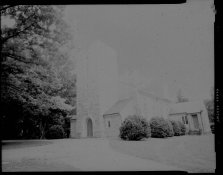Sirius Glass
Subscriber
These are two photographs that I took learning to correct for convergence. The negatives were quickly flat scanned saved; then GIMP was used to reverse the images and adjust the contrast so that they would be viewable.
Both negatives were taken with a Schneider-Kreuznech Angulon f6.8 90mm lens. In both photographs I thought that I had corrected for convergence, but on the right of both of them there is convergence. The one of Haper's Ferry has slight convergence and the one of the church has a larger convergence.
Are the convergences an artifact of the lens or an Operator Assisted Failure [OAF]?
Steve
Both negatives were taken with a Schneider-Kreuznech Angulon f6.8 90mm lens. In both photographs I thought that I had corrected for convergence, but on the right of both of them there is convergence. The one of Haper's Ferry has slight convergence and the one of the church has a larger convergence.
Are the convergences an artifact of the lens or an Operator Assisted Failure [OAF]?
Steve










 but the resulting frame will obviously be tilted 20° to the left.
but the resulting frame will obviously be tilted 20° to the left.



